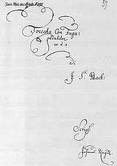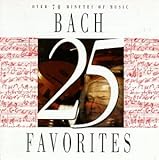Toccata Fugue
Cover Page with attribution to J S Bach

Circa 1750
Bach’s Toccata and Fugue in D minor (BWV 565) is perhaps Bach’s most popular work, although some modern scholars (since the 1980s) dispute the authenticity of Bach being its true author. You can see a likeness of the first page of the oldest surviving copy (circa 1750) of the work on this page. While clearly attributed to Bach on the title page of the same work, it is without his signature. Regardless, it is thought to have been written around 1705, relatively early in Bach’s life. See Timeline down below.
The piece is stirring and powerful, though not as complicated as many of his other organ works. Some think the piece was transcribed for the organ and initially composed for solo violin. Since young Bach, on his travels, was known to “play for his supper” using his violin, there may be some merit to this theory.
Toccata and Fugue in D minor has become synonymous with the cue:
> play ominous sounding music<.
This is probably because of associations with early movies and plays like Phantom of the Opera, Dracula, and other scary storylines. However, originally it was likely played as church music. Bach was, after all, a church musician most of his life and during this time he would have been Church Organist in Arnstadt at St Boniface.
According to historians, the piece caused quite a stir when played in a sacred church setting for the first time. It would not be the last time that the Composer's passion and genius would conflict with the norms and traditions of his day. Fortunately, he did not let the disapproval of others dampen his desire to create beautiful arrangements.
It is ironic that while Bach's work is now considered by many classical musicians to be the gold standard for technical purity, he was very much considered an innovator who was sharply criticized for departing from the traditions of the time. He was not popularly appreciated until long after his death. Considering how modern "innovators" are scorned by their purist peers, one wonders where the next great talents are today? No doubt, they are passionately engaged in solitary pursuit of contemporary discovery, pushing the technical limits of their craft while being scorned by the high brow purists who can not see past their highly lifted noses. My how things do not change. May the pomp and circumstance of those steadfastly looking to preserve the high values of the past not hamper the energy and creativity of those who are resolutely committed to looking forward to new vistas and heights yet unknown. How can we wonder where the modern Bachs are if we suppress the innovation that allows them to flourish?
This movie below is an award winning introduction to the great composer. Enjoy Glory to God Alone: The Life of J.S. Bach.
This interactive timeline will give some sense of several of the major events in Bach's life, but more detail can be found in the excellent resources listed above on the right sidebar.







